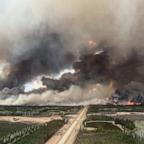Asking a machine to spot threats human eyes miss
— -- The surveillance cameras at Big Y, a Massachusetts grocery chain, are not just passively recording customers and staff. They're studying checkout lines for signs of "sweethearting."
That's when cashiers use subtle tricks to pass free goods to friends: obscuring the bar code, slipping an item behind the scanner, passing two items at a time but charging for one.
There simply aren't enough watchful human eyes to keep it from happening. So Big Y is using technology to block it — with implications far beyond dishonest cashiers.
Mathematical algorithms embedded in the stores' new security system pick out sweethearting on their own. There's no need for a security guard watching banks of video monitors or reviewing hours of grainy footage. When the system thinks it's spotted evidence, it alerts management on a computer screen and offers up the footage.
The possibilities that researchers envision for this kind of technology have the ring of science fiction. Think of systems that spot abandoned packages on a train platform or alert an airline crew to a potential terrorist on board. Already, cities like Chicago have invested in "anomaly detection" cameras around town, linked to emergency headquarters. The city plans to announce this week that it is using the technology at Navy Pier, one of Chicago's best-known attractions.
But just how smart have these cameras really become?
"Some of the claims that are made are just ridiculous," says Oliver Vellacott, the chief executive of IndigoVision, a British company that makes video-analysis technology. "That you're going to spot suspicious behavior in people about to stab someone on the street."
Big Y's security system comes from a Cambridge, Mass.-based company called StopLift. The technology works by scouring video pixels for various gestures and deciding whether they add up to a normal transaction at the register or not.
In the middle of a six-month trial, Mark Gaudette, Big Y's head of loss prevention, decided he'd seen enough and began rolling out the system in all of the chain's 58 locations.




